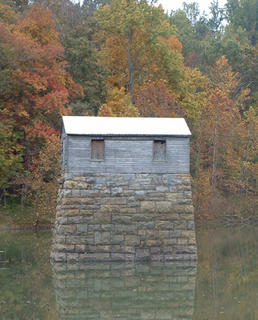Buildings and Bridges
One might not expect to find a lot of architectural history in a hiking guidebook, but whenever applicable I mention important or interesting structures in 60 Hikes within 60 Miles: Richmond. Not surprisingly, given the area's long past, one often has ocassion to encounter a curious, if crumbling, building in the Virginia countryside. Below are some that stand out, in varying states of repair.

Having escaped damage during the Civil War, Fluvanna County Courthouse in Palmyra remains unadorned and uncompromised by additions. Its Acropolis-like hilltop location recalls that of Virginia's Thomas Jefferson-designed capitol. (Visit the town now, before the Charlottesville suburbs swallow it.)


Not far from Palmyra is the Federal-style Haden House (above), which may yet be revovated. Attached by a covered walk, the kitchen, with its large stone oven, is a little the worse for wear but fortunately never caught fire.

George Washington's boyhood home was burned to the ground, but that didn't stop Rockefeller and other admirers from erecting this Coloinial-style mansion with a clapboard kitchen as a memorial. The foreground of this shot shows the location of the Washingtons' more modest home, which is outlined in crushed oyster shells.

St. Mary's Whitechapel on the Northern Neck was first built in the 17th century. This building is an early 18th-century replacement, but still a well-preserved example of Colonial ecclesiastical architecture. Note the entrance on the wider dimension and the absence of a steeple.

Ramshackle clapboard churches like this one are a common, often charming site along rural Virginia roads.

The weathered wooden pumphouse(?) in the upper half of Charlottesville Reservoir stands on a pediment of rusticated stones, which is submerged at high water levels. At lower levels, the revealed pedestal appears comically surreal, especially because nothing remains of the footbridge that presumably linked the pumphouse to the earthen dam (just out of sight in this image).

This 1890 home now in Zoar State Forest replaced an earlier structure erected by Robert Pollard in the 1790s. Because he found the nearby crossroads of Ayletts a den of iniquity, Pollard named his home Mount Zoar in reference to the Biblical city where Lot took refuge after fleeing Gommorah. Perhaps ironically, flames engulfed the original manse in 1885.

When built in the 1930s, this Albermarle barn was an agricultural showplace. It had a milking parlor and accomodated a variety of livestock. The owner was an agricultural extension agent; an African American, he was the first agent assigned to serve black farmers in the area.

Richmond's Boulevard Bridge opened in roaring 1925 for the convenience of the city's growing south-of-the-river suburbs. As a sort of linguistic memory, many people still refer to it as the Nickel Bridge (the modern toll is a quarter).

This New Deal-era swinging bridge over the Willis River in Cumberland State Forest was perhaps by the CCC but more likely by the WPA. Its steel cables and log beams remain sturdy, though the floorboards inspire some trepidation.
No comments:
Post a Comment